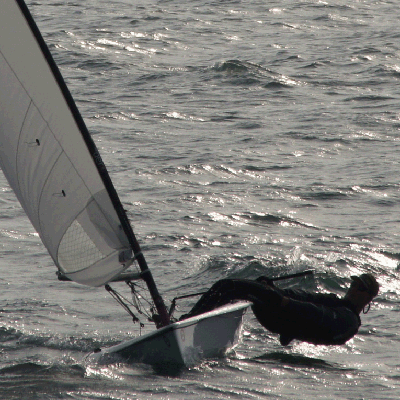
Welcome to the International Class Association website for the RS Aero. Here you will find all there is to know about the RS Aero including the latest news, how to register your boat, and links to relevant documents.
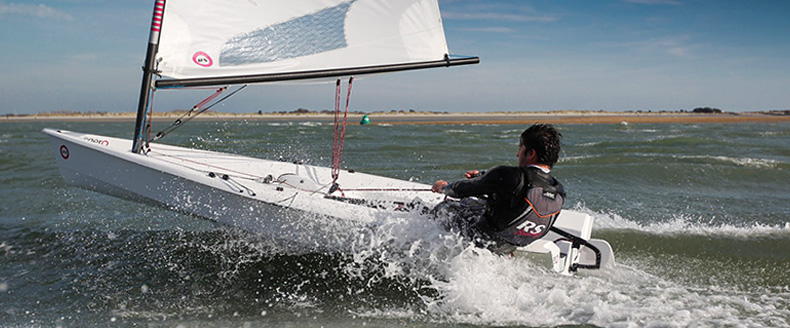
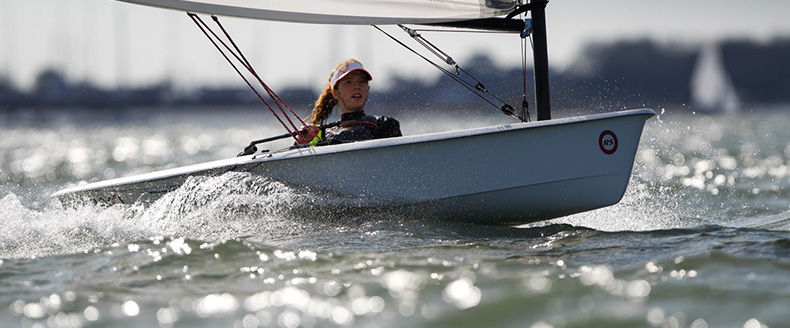
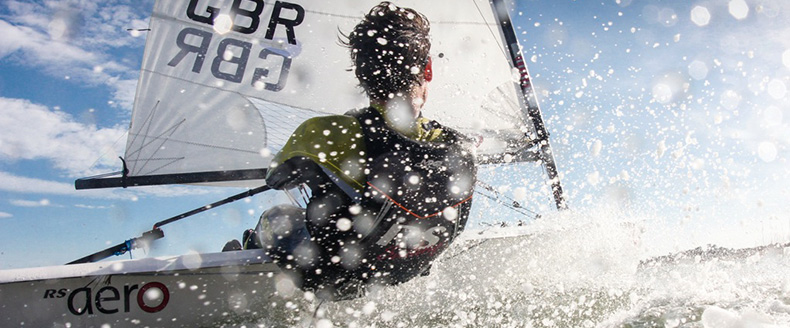
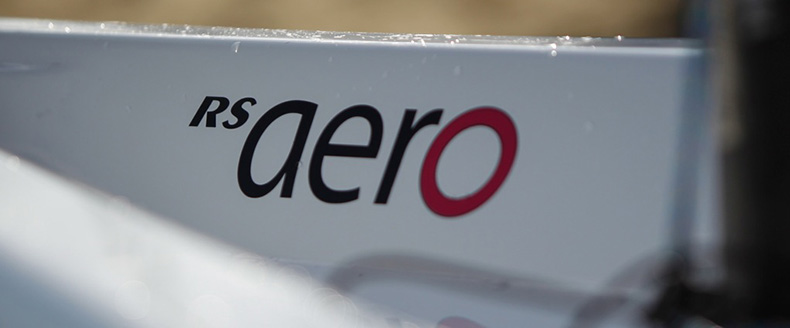
| Home >> Technical >> Halyard Mushroom |
Always apply lots of downhaul to bed the rope into the top cleat after hoisting. Pump it a few times to stretch out the bobble loop. If the sail dropped more than 1/2 inch pull it back up and repeat.
Second, tie an elastic (like the plate elastic with a clip on the end) to the top block of the downhaul, then put a loop know in the halyard a few inches above the lower cleat and clip the elastic there to apply releasing force to the downhaul, then cleat in lower cleat. The elastic helps free downhaul, but also keeps the halyard tight when it comes off the mushroom when you apply lots of kicker/downhaul and the mast bends.
Reply
Second, tie an elastic (like the plate elastic with a clip on the end) to the top block of the downhaul, then put a loop know in the halyard a few inches above the lower cleat and clip the elastic there to apply releasing force to the downhaul, then cleat in lower cleat. The elastic helps free downhaul, but also keeps the halyard tight when it comes off the mushroom when you apply lots of kicker/downhaul and the mast bends.
Reply
08/07/2020 13:15:00
Gareth
Posts: 170
Hi guys,
Thanks a lot for this tread it makes great sense why sail sag may happen...
Had some nightmares of sail sag following capsizing. And as I cannot rehoist the sail at sea being in the boat. I stay capsized but then the real nightmare starts when upper mast starts separating from lower section. To prevent this I simply fitted an elastic between the mastrooms. Just a tip. Best would be to avoid sail sag at all.
Reply
Thanks a lot for this tread it makes great sense why sail sag may happen...
Had some nightmares of sail sag following capsizing. And as I cannot rehoist the sail at sea being in the boat. I stay capsized but then the real nightmare starts when upper mast starts separating from lower section. To prevent this I simply fitted an elastic between the mastrooms. Just a tip. Best would be to avoid sail sag at all.
Reply
05/07/2020 15:17:00
Dk
Posts: 3
I make a full turn around mast mashroom (the one next to the joint). Can be done with a stick or by heeling a boat. This 100% prevents jumping off when sailing.
Reply
Reply
25/12/2015 08:55:43
albert
Posts: 3
I have had several instances of sail sag due sail halyard pulling through the cleat at the top of the mast.
This happens mostly in strong gusty conditions or when the mast head has gone into the water, not necessarily a capsize. One memorable incident was after a full 180 flick flack, from in on starboard side straight over to in on port side.
My upper mast has the port side mushroom, just above the join with the lower mast.
But the last online rigging manual I looked at, late May, simply showed the halyard tail passing around a mushroom on a very short section of mast; not exactly clear which, upper or lower section!!
I have now had the boat 7 months, but only in May did I spot the mushroom up the Port side, and realise its true significance, when doing a dry test hoist of a 9 sail.
By wrapping the halyard tail around the mast the halyard is kept firm in the mast head cleat, and the halyard tail does not flap loosely when the mast is subsequently bent, as it will be, when any kicker tension is applied.
Any mast bend reduces the direct distance between the upper & lower cleats, allows the halyard tail to flog, against the luff of the sail, not good, & over a long race or series of (Sunday club) races will loosen the halyard grip in the upper cleat; and sail sag!!
RS I don't think this can be stressed enough, and that the May edition of the on-line rigging guide just does not give sufficient emphasis to this.
A diagram showing the full halyard & tail run, together with suitable text to emphasise the importance of such routeing would, in my opinion, save a lot of grief.
How does the upper mast section mushroom get missed so easily?
Well I always assemble the mast sections lying sail track up, to ensure the two sections are fully home, and the track is aligned with no snag at the join.
Then I check the halyard isn't twisted and both sides are secured in the lower cleat.
Then I step the mast.
From then on I'm either looking at the top of the mast, or the lower cleast & gooseneck area; some obscure mushroom halfway up - no chance - until now!!
Reply
12/06/2015 21:02:03
Jonathan Rickels
Posts: 104
Correct the early boats did not have the upper Mushroom. Please contact me if you want to retrofit them. 00 44 (0) 1794 526 765 [email protected]. Regards Jnr
Reply
Reply
20/01/2015 15:03:22
Posts: 0
I presume the early boats did not have them?
'Preferable, but not essential' is my suggestion. I recall my halyard jumping out from behind the upper mushroom on a windy day without any issue resulting.
Reply
20/01/2015 13:18:29
Peter Barton
Posts: 4664
Ok so now I know. My mast does not have the upper mushroom. Not having any problem since I made sure firmly in top cleat before tailing the halyard. (Apply lots of downhaul to settle it into the cleat). Anyone think it is worth retrofitting?
Reply
20/01/2015 13:00:31
Gareth
Posts: 170
Sandy,
You are correct in your use of both 'shrooms.
The lower 'shroom ensures that with outhaul tension being applied, you are not pulling at a strange angle for the sail by keeping the tack close-ish to the gooseneck.
Matt
Reply
19/01/2015 20:18:37
Matt Thursfield
Posts: 33
I have two mushrooms on my mast. One is a third of the way up the mast on the port side. I take the tale of the halyard around the front of the mast, and then behind / aft of this mushroom, before cleating the halyard tail in the lower cleat.
The second mushroom is on the very front of the mast, down around the height of the sail's tack strap. I don't know what this mushroom is for. Maybe to prevent the tack strap from riding up the mast?? Any ideas?
Reply
16/01/2015 10:16:44
Sandy Goodall
Posts: 30
Hi Gareth
I can help you with this. Give me a call direct on 01794 526 765 or email me [email protected] and we can work through the issue and sort it out.
Best regards
Jnr
RS Customer Support
Reply
16/01/2015 09:28:27
Posts: 0
I have a mushroom but it is below the lower cleat so I don't understnd the reference above to the mushroom and any tension between upper and lower cleats. I will review the user guide again but just making sure the rope is firmly settled in the upper cleat seems to do the trick. IMO the lower cleat is more for use to hold the cover up, but it does help keep the tail tidy.
BTW What is the mushroom on the hull in front of the kicker for?
Reply
16/01/2015 02:06:18
Gareth
Posts: 170
I had no problem with the 7 rig in the Bloody Mary and you aren't going to get any windier than that! I just made sure that I tensioned the luff and got everything settled in the upper cleat before I tidied up the halyard tail. Didn't put much tension on the lower cleat.
Reply
13/01/2015 13:59:57
Gareth
Posts: 170
This weekend I hoisted sail, cleated it, mushroomed and lower cleated the tail but with very little tension, just enough to ensure it stayed behind mushroom - it stayed there through two very windy races.
So as Gareth said, not too much tension on the tail and it should stay put.
Thanks
M
Reply
12/01/2015 20:48:34
Matt Thursfield
Posts: 33
Gareth, do you have the mushroom on your mast as that was a fairly late addition I believe. Without the tension, with mast bend with kicker, has yours uncleated at all?
That could be the solution, no tension and a floating/flapping halyard.
Matt
Reply
Reply
04/01/2015 22:37:13
Matt Thursfield
Posts: 33
Sounds like what happened to me last week - I'm sure i was cleated at the top but it came out so only the thin tail left holding the sail up. This week I made sure the top was well in and the tail not too tight so the tail couldn't cause the top cleat to release.
Reply
04/01/2015 21:24:21
Gareth
Posts: 170
Hi Simon.
I'm good with the halyard being two piece, it's the first thing to make sure people know about though.
If the halyard works past the mushroom, then the angle from cleat to cleat with max kicker then uncleats the top cleat leaving the bottom cleat with the resistance to stop the top cleat completely uncleating!!!!!!! Hence the drop by the couple of inches. Letting kicker off then relengthens the halyard putting huge pressure on that lower cleat.
So I need to stop the mushroom being bypassed during sailing. The question is "which point of sailing triggers that to happen, kickering, gybe, tacking????
If I know that, I will know where to start with finding the solution. If anyone knows that I'd be grateful.
Regards.
Matt
Reply
Reply
04/01/2015 21:15:27
Matt Thursfield
Posts: 33
I'll check the sail - probably didn't see the pocket it cos the top cleat is on the right. (Unless my ex demo doesn't have that - probably me just not noticing.) Kicker looks to be 16:1. It seems strong enough to do its job but in a blow I found I couldn't just pull it on but had to sheet in fully first and then take up the strain with the kicker to hold the shape when I then played the sheet.
Reply
Reply
04/01/2015 19:41:13
Gareth
Posts: 170
Gareth, without the top cleat, there will be little luff tension. The mast is more windsurfer bend than some dinghies, so halyard tail needs to be tidied or its back alongside the sail.
Each sail has a nice Velcro pocket on the port side to put the Halyard in so nice and tidy.
Download the latest rigging manual to check your kicker set up. It's a very powerful control and I certainly haven't felt it needs more purchase than standard.
Reply
Reply
04/01/2015 19:06:50
Posts: 0
I had the top pop out of the cleat last week - probably had too much tension on the tail so when the mast bent it pulled it out. Still went OK but much better this week with top cleat working.
Supplementary question - what do you all do with the tail f the halyard? I've been tying it in a coil to the bottom of the mast. Thinking about adding a couple of elastic bands round the mast to hold the tail.
Further supplementary - finding the only way to get the kicker tension I want is by sheeting in hard first - is that what everyone's doing. used to Sole with a better angle of pull where you can adjust kicker even without sheet tension.
Thanks
Gareth
Reply
04/01/2015 18:32:13
Gareth
Posts: 170
I may be teaching you to suck eggs here, but the aero has a two piece halyard and the only important bit is the short bit of dyneema that is at the top of the mast. That needs to cleat into the cleat at the TOP of the mast and is pulled down and forward to lock. This is classic catamaran practice and minimises the risk of halyard stretch.
The mushrooms and the cleat and sail pocket are only to tidy away the 'tail' of the Halyard. They should have absolutely no affect on luff tension. if you rely on the thin stretchy tail and the cleat by the boom, your sail will always drop.
Reply
04/01/2015 18:04:36
Posts: 0
During racing yesterday at the Oxford Blue, my mainsail started to drop a few inches during the second race in the stronger breeze. I noticed that the halyard had worked its way around the mushroom on the mast. I had made sure there was lots of tension before cleating in the lower cleat.
So in between races, I rehoisted, recreated, remushroomed. It did it again.
I need a solution as a lower mainsail has a variety of consequences.
My thoughts are an extra mushroom on the opposite side of the mast, a "taller" mushroom or maybe even three.
I know Mark Tissiman had the same issue, and I think Pete B did too.
Anyone else. Any other suggestions for a solution???
Matt
Reply
Reply
04/01/2015 15:49:10
Matt Thursfield
Posts: 33







